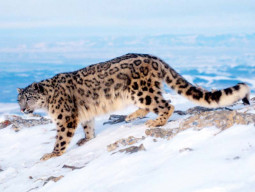
Dubbed Sivatherium giganteum, the impressive creature would have been shorter than today's giraffe, with a less elongated neck, a trio of British scientists wrote in the Royal Society journal Biology Letters.
Global warming puts snow leopards in a bind: study
Using bones dug up in India in the 1830s and now in London's Natural History Museum, the team built a computerised 3D reconstruction of an animal they said would have stood about 1.8 metres (5.9 feet) tall at the shoulder and weighed about 1.2 tonnes.
"This was a heavy animal with thick legs," co-author Christopher Basu told AFP by email.
Added to the large, flattened horns or "ossicones" on the top of the skull, each about 70 centimetres (28 inches) long, it also had two smaller, pointy horns just over the eyes.m
"It would have been an impressive and strong animal," said Basu. "It's face would have looked very different from a giraffe. Giraffe's have very long, pointed skulls. Sivatherium had a very short, flattened skull."
It lived somewhere between the last five million and 12,000 years ago.
Related to the giraffe and its cousin the okapi, Sivatherium was possibly the largest ruminant animal -- those with multi-compartmented stomachs - to ever have lived.
Himalayan Leo: Pakistan to seek return of snow leopard from US
The first scientists to study Sivatherium bones misclassified the animal as an archaic link between modern ruminants and a long-extinct relative of elephants and rhinoceroses.
For the new study, the skeleton was reconstructed using 26 fossil bones from three individual animals. The ribs, back and pelvis are missing.
"We estimated what these might look like from giraffe and okapi anatomy - the two living relatives," said Basu.










































COMMENTS
Comments are moderated and generally will be posted if they are on-topic and not abusive.
For more information, please see our Comments FAQ